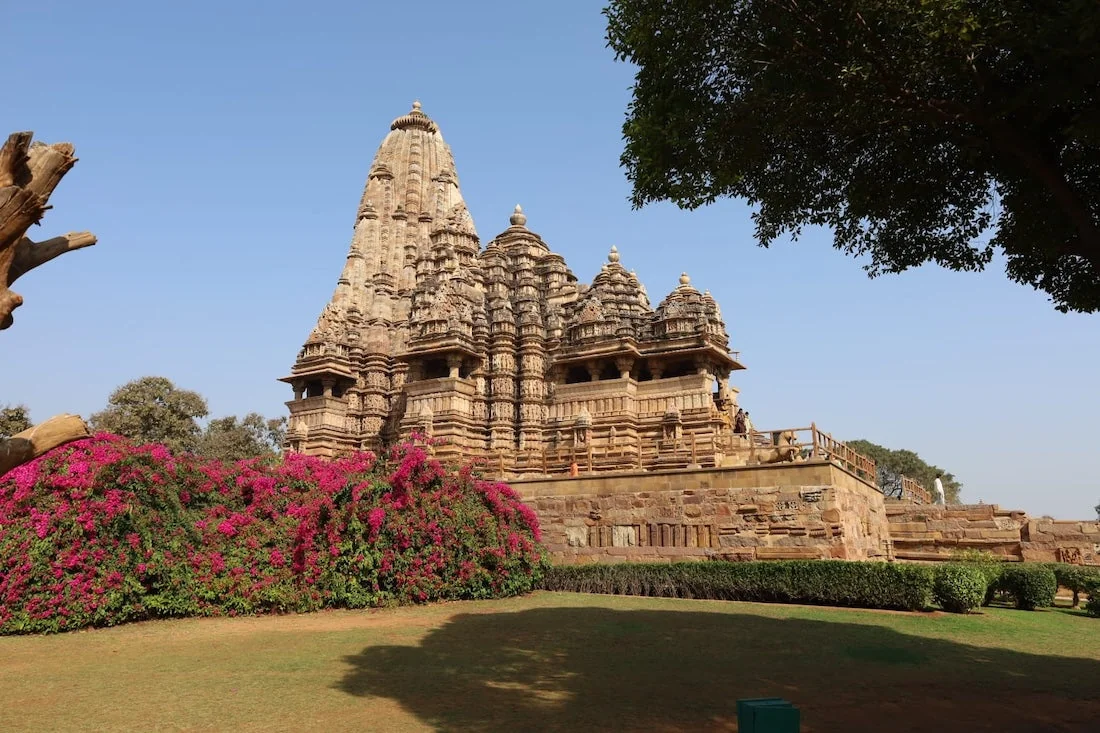Khajuraho – Part 2

Khajuraho: A Sacred Journey Through Time and Art (Part 2)

The Temple City: A Historical Perspective
Khajuraho’s temples stand as a testament to the artistic vision of the Chandela dynasty, who ruled this region between the 9th and 13th centuries. Originally numbering around 85 temples, only 25 remain today, each a masterpiece of medieval Indian architecture. In 1986, these temples were rightfully recognized as a UNESCO World Heritage Site.
The temples are divided into three geographical groups: Western, Eastern, and Southern. The Western group contains the largest concentration and most renowned structures, including the magnificent Kandariya Mahadeva Temple, dedicated to Lord Shiva.

The name “Khajuraho” itself derives from the Sanskrit word “khajur,” meaning date palm. Historical records suggest that these temples were once adorned with golden date palm trees at their entrances, though none survive today. The temples were gradually abandoned after the decline of the Chandela dynasty, allowing them to escape much of the destruction that befell other Hindu temples during later periods.
What makes these temples particularly remarkable is that they were constructed without the use of mortar. Each stone block was precisely cut to interlock with adjacent pieces, creating structures of extraordinary stability that have withstood the test of time for over a millennium.
Architectural Brilliance

What distinguishes Khajuraho’s temples is their Nagara-style architecture, characterized by their soaring shikhara (spires) that seem to reach toward the heavens. These structures follow a symmetrical, grid-like design laid out according to sacred geometry principles from ancient Vastu Shastra texts.

The temples rise from high platforms (jagati), drawing the eye upward through carefully balanced proportions. The sanctuary towers reach heights of up to 31 meters, creating a visual rhythm that represents the sacred Mount Kailash, Shiva’s celestial abode.

The sandstone used in construction was quarried from nearby regions, its warm hues capturing the changing light throughout the day. At dawn, these structures appear golden; by midday, they radiate a bright amber; and at sunset, they transform into deep honey-colored monuments that seem to glow from within.
Each temple follows a progressive layout that represents the spiritual journey:
- The entrance (ardhamandapa) represents the beginning of spiritual pursuit
- The assembly hall (mandapa) signifies the gathering of spiritual seekers
- The sanctum sanctorum (garbhagriha) embodies the ultimate goal of union with the divine
It is perhaps interesting to note how the temples of all Great Religions (Churches, Mosques, Hindu and Jain Temples, Thai, Chinese and Japanese Temples, and so on) have the same structure. An outside space, a gate where you can enter at the condition of being purified, an internal space where all devotees can access, and finally a Sancta Sanctorum where only some Priests can stay and that contains the most precious image of the God.
The architectural elements themselves carry profound symbolic significance. The ascending spires represent the upward spiritual journey, while the dark inner sanctums symbolize the mysterious, unknowable nature of the divine that can only be experienced, never fully comprehended.
The Living Stone: Sculptural Masterpieces

What truly sets Khajuraho apart is its sculptures—over 2,000 figures that adorn the temple walls, each carved with remarkable precision and artistic sensitivity. These sculptures represent one of humanity’s greatest artistic achievements.

The figures depict celestial beings (apsaras), divine couples (mithunas), musicians, dancers, and scenes from daily life. The sculptors captured fleeting moments with extraordinary naturalism: a maiden removing a thorn from her foot, another applying kohl to her eyes, a dancer adjusting her anklet, or musicians lost in performance.
Here there is one of the Sardulas, at the entrance of Mahadeva Temple. A lion/human mythical creature, interacting with a nymph.

The technical mastery is astounding. Despite being carved from rigid sandstone, these figures convey remarkable fluidity and grace. The sculptors understood human anatomy with precision, portraying subtle muscle movements, the gentle curve of a waist, or the weight shift of a standing figure with remarkable naturalism.

These sculptures are arranged in horizontal bands around the temples, with each level representing different aspects of existence:
- The base level depicts everyday life and worldly pursuits
- The middle sections show divine beings and celestial activities
- The highest levels represent purely spiritual realms
This arrangement mirrors the Hindu concept of spiritual ascension—from material concerns to divine consciousness.
The sculptural traditions here reflect a society with a profound appreciation for both spiritual and earthly beauty. The level of detail is extraordinary—from the intricate jewelry adorning the figures to the expressive facial features that convey a range of emotions. Even the positioning of hands (mudras) carries specific meanings related to various states of consciousness or divine attributes.

The Celebration of Life: The Erotic Sculptures

Perhaps most famous—or misunderstood—are Khajuraho’s erotic sculptures, which constitute approximately 10% of the temple artwork. These carvings depict couples and sometimes groups engaged in intimate acts, portrayed with both artistic sophistication and spiritual significance.
These sculptures have been reduced by many outside observers to mere pornographic curiosities. However, they represent something far more profound within Hindu philosophy. They embody the integration of physical pleasure (kama) as one of life’s legitimate goals alongside spiritual liberation (moksha), duty (dharma), and prosperity (artha).

According to traditional interpretations, these sculptures serve multiple purposes:
First, they symbolize the union of opposites—the divine masculine and feminine principles whose integration is necessary for cosmic harmony. The merging of Shiva and Shakti represents the ultimate spiritual truth of non-duality.

Second, they serve as tantric teaching tools, showing how physical energy can be transformed into spiritual awakening. The intimate poses often correlate to specific yogic postures and energy channels within the body.
Third, they demonstrate that to reach spiritual heights, one must first acknowledge and transcend human desires rather than deny them. They represent the frank recognition that desire is part of the human condition.

Some scholars suggest these explicit carvings also served as tests for those entering the temples—if visitors were distracted or disturbed by these images, it indicated they were not yet spiritually prepared for the deeper teachings within.
The sculptures portray intimacy with remarkable sensitivity. The faces express genuine emotion, the body positions demonstrate authentic intimacy, and the overall execution conveys an atmosphere of mutual pleasure rather than exploitation. The women are portrayed as equal participants rather than passive objects, reflecting the relatively egalitarian gender attitudes of medieval Hindu society.

As you walk among these temples, you witness not just artistic mastery, but a profound philosophical statement about the integration of all aspects of human experience—physical, emotional, and spiritual—into a harmonious whole.

